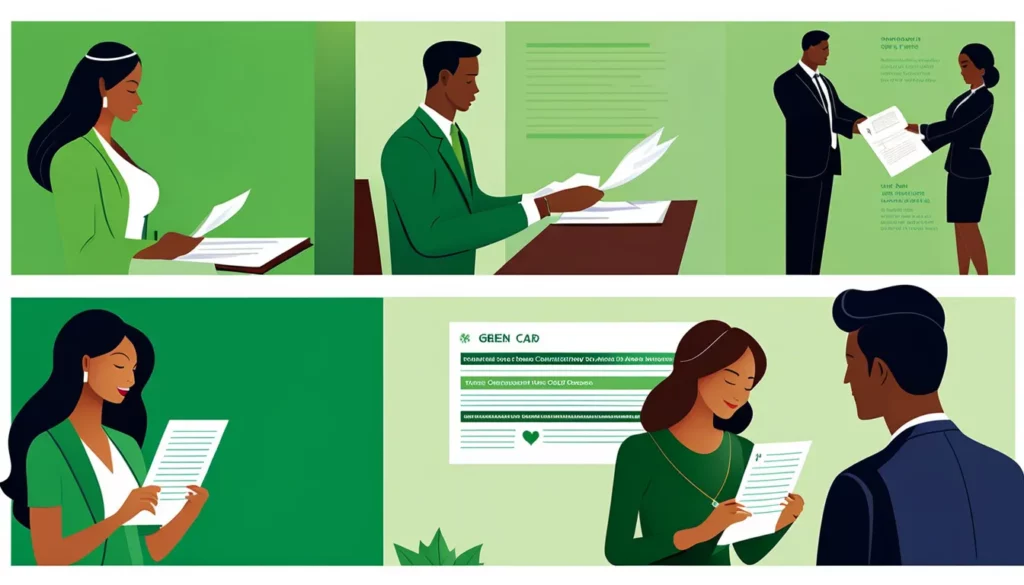The dream of living in the United States can become a reality by marrying a U.S. citizen outside the United States. Obtaining a Green Card after marriage may seem complex; however, with the right information and proper planning, you can do it.
We understand the importance of this process, which is why at Jaskot Law, we will provide you with detailed information, from the requirements to the steps to follow, so that you can successfully complete this process and begin your journey to living in the United States.
What is a Green Card?
A Green Card is a document issued by the U.S. Government that grants an individual permanent resident status in the United States. This means that the person has the legal right to live and work indefinitely in the country.
Obtaining a Green Card can be done through various means, such as family sponsorship, marriage, refugee or asylee status, among others. Once obtained, it is essential to maintain your permanent resident status by complying with immigration laws and avoiding certain crimes that could lead to the loss of such status.
Eligibility to apply for a Green Card
Green Cards are available for several categories of eligible individuals. Some of the most common categories include:
- Relatives of U.S. citizens or permanent residents: Immediate relatives of U.S. citizens, such as spouses, unmarried children under the age of 21, and parents, as well as relatives of permanent residents, may be eligible to obtain a Green Card through family.
- Sponsored employees: Those who have employment offers in the United States and are sponsored by a U.S. employer may be eligible for an employment-based Green Card.
- Refugees and asylees: Refugees and asylees who have been admitted to the United States may apply for a Green Card after one year of continuous residence in the country.
- Diversity Visa Lottery Winners: Each year, the Diversity Visa Lottery program awards Green Cards to individuals from countries with low rates of immigration to the United States.
- People fleeing persecution or violence: Those who have been victims of persecution or fear of being persecuted in their home country because of their race, religion, nationality, membership in a particular social group or political opinion may be eligible for asylum or refugee status, which can lead to a Green Card.
Don’t know what category your case falls into, or are you unsure about making a mistake? Don’t worry, at Jaskot Law, we understand how overwhelming the immigration process can be, so we provide you with the tools to ease the burden.

Stage 1: Sponsorship Process
The process to apply for a Green Card when marrying a U.S. citizen outside the United States begins with sponsorship. With it, your spouse must ensure that you have adequate financial resources when you become a permanent resident. This process includes the following steps:
| Complete and sign the Form I-130 Petition for Alien Relative and the Form I-130A Supplemental Information for Beneficiary Spouse. You should be the one to sign and file these forms, not your spouse. |
| Prepare all the supporting documents required, according to the instructions on the forms you submit, including proof of your U.S. citizenship,marriage certificate, evidence of marriage, evidence of authenticity of your relationship,proof of divorce if either of you were previously married, four passport photos (two of you and two of your spouse) and a cover letter, which is optional. |
| Make payment of the $535 filing fee by check, money order, credit/debit card, or by Form G-1450. |
| In approximately two weeks, you should receive an official notice that USCIS received the I-130 and I-130A forms you filed. |
| Keep the USCIS informed in case you change your mailing address. |
| Respond to any Request for Evidence (RFE) you receive from USCIS. Although not all applicants receive a Request for Evidence, this is not unusual. If you receive one, you will be asked to submit additional evidence so that your sponsorship application can be processed. |
| Finally, you should receive a notice of approval within 7 to 10 months. |
It is important to start this first stage of the process on the right foot, which is why, at Jaskot Law, we can provide you with the guidance you need to navigate these steps safely and get positive results.
Step 2: Green Card Application Process
Once they confirm the availability of a Green Card, the National Visa Center (NVC) will be responsible for accepting your application. In addition, it will evaluate if everything is ready to carry out a procedure known as “Consular Processing.”
As in the previous step, this second step to apply for permanent residency by marrying a U.S. citizen outside the United States is extensive. This process consists of several fundamental steps:
Initial Application
As in any immigration process, this stage begins with the filing of the initial application, which is followed by the subsequent steps:
- Initial Application: If your spouse resides in the United States, he or she must file Form I-485. If they reside abroad, they must apply for a U.S. immigration visa. Once on U.S. soil, your spouse will be considered a permanent resident, even if the Green Card has not yet arrived.
- Transfer to the NVC: Upon approval of the I-130 and I-130A forms by USCIS, the case will be transferred to the National Visa Center (NVC).
- Case number assignment: NVC will assign your spouse an NVC case number and a bill ID number. This information will be communicated through a welcome letter.
- Form DS-261: Your spouse must complete the Form DS-261, which allows the Department of State to establish communication during the pending visa process.
- Fee payment: A $445 online payment is required at the Department of State’s Immigrant Visa Bill Payment Center. This includes the government fee and the fee associated with the Affidavit of Economic Sponsorship.
- Form I-864 and financial documentation: Complete and submit the Form I-864 – Affidavit of Economic Sponsorship along with the required financial documentation, such as your most recent tax return.
- Form DS-260 and documentation: Your spouse must file Form DS-260 online and send Form I-864 and supporting documents to NVC.
- Possible request for evidence: NVC may request additional documentation within one to two months if needed to process the application.
Interview Process
Once the above steps have been completed, the interview stage and obtaining the Green Card will proceed:
- Medical examination: Your spouse must undergo a medical examination by a USCIS-approved physician at a cost of approximately $200. He or she will receive a sealed envelope to take to the visa interview, which must remain intact.
- Passport delivery: Your spouse must provide an address on the embassy or consulate website to send their passport once the immigration visa has been stamped.
- Green Card interview: Your spouse will attend an interview at the nearest U. S. embassy or consulate. Questions will be asked to determine the validity of the marriage, and your spouse will be required to bring the documentation requested in the visa appointment letter, including their passport and stamped medical examination results.
- Visa issuance: In case of a successful interview, a U.S. immigration visa will be stamped in your spouse’s passport. If the decision is delayed, the passport will be mailed.
- Green Card: You must pay an online immigrant fee of $220 to cover the production and delivery of the Green Card, which will be mailed to your spouse’s U.S. address within two to three weeks after arrival.
If the marriage is less than two years old as of the spouse’s entry into the U.S., Conditional Permanent Residence (CR1) will be granted, which will require an additional interview two years later to remove this condition. If you need help, Jaskot Law accompanies you every step of the way.

Conclusion
In summary, marrying a U.S. citizen outside the United States is a challenging but rewarding process. By following the proper steps and complying with the requirements mentioned in this article, you can achieve your goal of settling in the United States with your loved one.
Do not hesitate to contact us at Jaskot Law for personalized advice and answers to your specific questions. Our team of immigration law attorneys is here to help you every step of the way.
Sources
I-130, Alien Relative Petition
Form I-864 – Affidavit of Financial Sponsorship
Conditional Permanent Residence (CR1)
Frequently Asked Questions
What documents do I need to marry a U.S. citizen abroad?
You must have documents such as a valid passport, birth certificate, certificate of unmarried status or divorce (if applicable), affidavit of unmarried status, and recent passport photographs. In addition, the U.S. citizen must provide proof of identity and residency.
What is the role of the Fiancé Visa (K-1) in the foreign marriage process?
The Fiancé Visa (K-1) allows the foreign spouse to enter the United States to marry the U.S. citizen. It is a crucial step to start the process of obtaining a Green Card through marriage abroad.
How long does the entire Green Card process take when marrying a U.S. citizen outside the United States?
The total time of the process may vary depending on several factors, such as the location of the marriage and the workload of the authorities. In general, it can take several months from the beginning of the process to obtaining the Green Card. It is important to be prepared for possible delays and plan accordingly.
Is it possible to marry a U.S. citizen abroad if one of the spouses already has an immigration status in the United States?
Yes, it is possible to marry a U.S. citizen abroad, even if one of the spouses already has an immigration status in the United States. However, it is important to follow the proper procedures and comply with the legal requirements to ensure that the marriage is recognized by the immigration authorities.
Kemel stands out as a professional in writing and translating content for the Latin American market. With more than four years of experience, he began his professional career as a member of a research group, with which they dealt with various topics and wrote several scientific papers.


